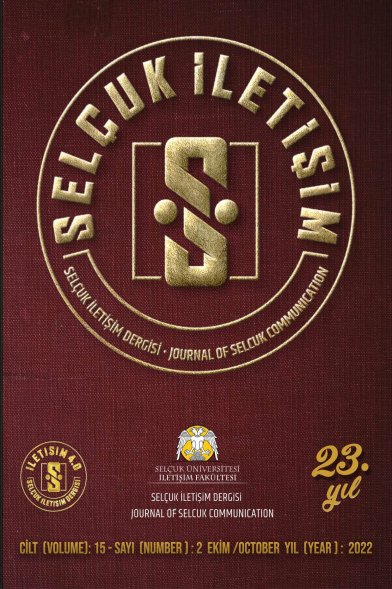FACEBOOK'TA BENLİK SUNUMU VE TOPLUMSAL CİNSİYET ROLLERİ
SELF-PRESENTATION AND GENDER ROLES ON FACEBOOK
___
- Armağan A (2013) Gençlerin Sanal Alanı Kullanım Tercihleri ve Kendilerini Sunum Taktikleri, Uluslararası Sosyal Araştırmalar Dergisi, 6 (27), 79-92.
- Biçer S (2014) Akademisyenlerin Sosyal Ağlarda Bulunma Motivasyonları: Facebook Örneği. Dumlupınar Üniversitesi Sosyal Bilimler Dergisi, (40), 59-80.
- Bond B J (2009) He Posted, She Posted: Gender Differences In Self-Disclosure On Social Networking Sites, Rocky Mountain Communication Review, 6(2) 29-37.
- Boz N (2012) Yeni İletişim Ortamlarında Dijital Kimlik ve Benlik Sunumu, Doktora Tezi, Marmara Üniversitesi Sosyal Bilimler Enstitüsü, İstanbul.
- Dökmen Z (2010) Toplumsal Cinsiyet: Sosyal Psikolojik Açıklamalar, Remzi Kitabevi, İstanbul.
- Ellison N, Heino R ve Gibbs J (2006) Managing Impressions Online: SelfPresentation Processes In The Online Dating Environment, Journal of ComputerMediated Communication, 11(2) 415-441.
- Erbaş T (2011) Türkiye'de TUMBLR Blog Ortamındaki Popüler Blogcuların Kullanım Pratikleri, Yüksek Lisans Tezi, Başkent Üniversitesi Sosyal Bilimler Enstitüsü, Ankara.
- Erdoğan İ (2012) Pozitivist Metedoloji ve Ötesi, Erk Yayınları, Ankara.
- Facebook Factsheet (2010). _____http://www.facebook.com/press/info.php?factsheet>. 09.10.2013 tarihinde erişilmiştir.
- Goffman E (2009) Günlük Yaşamda Benliğin Sunumu, Barış Cezar (çev), Metis, İstanbul.
- Gonzales A L ve Hancock J T (2008) Identity Shift in Computer-Mediated Environments, Media Psychology, 11(2), 167-185.
- Guadagno R E, Muscanell N L, Okdie B M, Burk N M ve Ward T B (2011) Even in Virtual Environments Women Shop And Men Build: A Social Role Perspective On Second Life, Computers in Human Behavior, 27 (1), 304-308.
- Hancock J T ve Toma C T (2009) Putting Your Best Face Forward: The Accuracy Of Online Dating Photographs, Journal of Communication, 59 (2), 367-386.
- http://www.socialbakers.com/facebook-statistics/ 09.10.2013 tarihinde erişilmiştir.
- http://www.alexa.com/topsites/countries/TR 09.10.2013 tarihinde erişilmiştir.
- Hum N J, Chamberlin P E, Hambright B L, Portwood A C, Schat A C ve Bevan J L (2011) A Picture Is Worth A Thousand Words: A Content Analysis Of Facebook Profile Photographs, Computers in Human Behavior, 27(5), 1828-1833.
- Junco R ve Cole-Avent G A (2008) An Introduction To Technologies Commonly Used By College Students, New Directions for Student Services (124), 3-17.
- Kassarjian H H (1977) Content Analysis in Consumer Research, Journal of Consumer Research, 4 (1), 8-18.
- Lenhart A (2009) PEW Internet Project Data Memo. PEW Internet & American Life Project, 2, 17, http://www.pewinternet.org/~/media/Files/Reports/2009/PIP_ Adult_ social_networking_data_memo_FINAL.pdf.pdf 12.10.2013 tarihinde eri- şilmiştir.
- Melcombe M (2011) Women's Perceptıons Of Identıty Constructıon On Facebook, Master Thesis, Gonzaga University, Washington.
- Mesch G S ve Beker G (2010) Are Norms Of Disclosure Of Online And Offline Personal Information Associated With The Disclosure Of Personal Information Online?, Human Communication Research, 36 (4), 570-592.
- Morgan E M, Snelson C ve Elison-Bowers P (2010) Image And Video Disclosure Of Substance Use On Social Media Websites, Computers in Human Behavior, 26(6), 1405-1411.
- Pempek T A, Yermolayeva Y A ve Calvert S L (2009) College Students' Social Networking Experiences, Journal of Applied Developmental Psychology, 30(3) 227-238.
- Reichart S L ve Cooley S (2008) Face-ism On Facebook: An Analysis Of SelfInflicted Face-Ism In Online Profile Pictures. Paper presented at annual convention of the International Communication Association, Chicago, IL.
- Stern L A ve Taylor K (2007) Social Networking on Facebook, Journal of the Communication, Speech, and Theatre Association of North Dakota, (20) 9-20.
- Sussman N M ve Tyson D H (2000) Sex and Power: Gender Differences In Computer Mediated Interactions, Computers in Human Behavior, (16) 381-394.
- Şahan H G (2013) Lokasyon Bazlı Sosyal Ağlar Aracılığıyla Selektif Benlik Sunumu, Yüksek Lisans Tezi, İstanbul Üniversitesi Sosyal Bilimler Enstitüsü, İstanbul.
- Utz S (2010) Show Me Your Friends and I Will Tell You What Type Of Person You Are: How One's Profile, Number Of Friends, And Type Of Friends Influence Impression Formation On Social Network Sites, Journal of ComputerMediated Communication, 15 (2), 314-335.
- Valenzuela S, NamsuPark ve Kee K F (2009) Is There Social Capital In A Social Network Site? Facebook Use And College Students' Life Satisfaction, Trust, And Participation, Journal of Computer-Mediated Communication, 14 (4), 875-901.
- Walker K (2000) It's Difficult To Hide It': The Presentation Of Self On Internet Home Pages, Qualitative Sociology, 23(1), 99-120.
- Walther J B, Van Der Heide B, Sang-Yeon K, Westerman D ve Tom Tong S (2008) The Role Of Friends' Appearance And Behavior On Evaluations Of Individuals On Facebook: Are We Known By The Company We Keep?, Human Communication Research, 34(1), 28-49.
- Yıldırım A ve Şimşek H (2011) Sosyal Bilimlerde Nitel Araştırma Yöntemleri, Seçkin Yayıncılık, Ankara.
- Yurchisin J, Watchravesringkan K ve McCabe D B (2005) An Exploration Of Identity Re- Creation In The Context Of Internet Dating, Social Behavior and Personality, 33(8), 735-750.
- Watson S W, Smith Z ve Driver J (2006) Alcohol, Sex, And Illegal Activities: An Analysis Of Selected Facebook Central Photos In Fifty States, (ERIC Document Reproductive Service No. ED493049), http://files.eric.ed.gov/fulltext/ED 493049.pdf 12.10.2013 tarihinde erişilmiştir.
- Zhang J (2010) Self-Enhancement On A Self-Categorization Leash: Evidence For A Dual-Process Model Of First- And Third-Persona Perceptions, Human Communication Research 36 (2), 190-215.
- Zhao S, Grasmuch S ve Martin J (2008) Identity Construction On Facebook: Digital Empowerment In Anchored Relationships, Computers in Human Behavior, 24(5), 1816-1836.
- Yayın Aralığı: Yılda 2 Sayı
- Başlangıç: 1999
- Yayıncı: Selçuk Üniversitesi İletişim Fakültesi
FACEBOOK'TA BENLİK SUNUMU VE TOPLUMSAL CİNSİYET ROLLERİ
LİDERLER VE TAKİPÇİLERİ: SİYASİ PARTİ LİDERLERİNİN TWİTTER PERFORMANSLARI VE TAKİP İLİŞKİSİ
DERGİ TAM METNİ (BİRLEŞTİRİLMİŞ TEK PDF DOSYASI)
DİJİTAL OYUNLARA "OYUN TÜRÜ" YAKLAŞIMLARININ SORUNLARI: "PLATFORM OYUNLARI" TÜRÜ ÖRNEĞİ
ÇEVRE EĞİTİMİNDE KAMUSAL HALKLA İLİŞKİLER VE STK'LAR İLE İŞBİRLİĞİ
İYİ HABER DE İYİ HABER MİDİR? HABER DEĞERLERİ ÜZERİNE BİR İÇERİK ANALİZİ ÇALIŞMASI
Erkan YÜKSEL, Hatice KAHRAMAN ADIYAMAN, Nursen AYDIN, Bilgen KURT, Canver ÇELİK, Emine KARAOĞLU, Mine DEMİREL
NURİ BİLGE CEYLAN SİNEMASININ ANLATISAL DÖNÜŞÜMÜ: FOTOĞRAFİK ANLATIMDAN, ÖYKÜSEL ANLATIMA
ÜNİVERSİTE ÖĞRENCİLERİNİN YEREL GAZETE OKUMA ALIŞKANLIKLARI: KONYA ÖRNEĞİ
KURUMSAL YÖNETİŞİM VE HALKLA İLİŞKİLER: HALKLA İLİŞKİLER UZMANLARIYLA NİTELİKSEL BİR ARAŞTIRMA
11 EYLÜL SONRASINDA HOLLYWOOD'DA MİTOLOJİK YAKLAŞIMLAR VE ARKETİPLER
